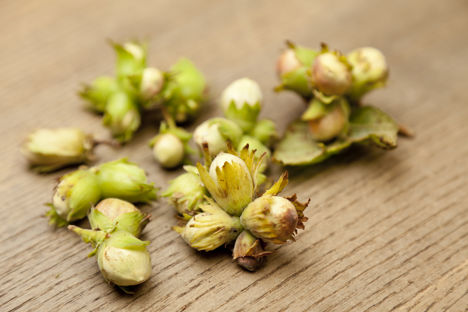
Ingredient focus: cobnuts
Once a British favourite, cobnuts all but disappeared from the landscape in the twentieth century but now they are making a comeback thanks to a new wave of chefs championing British ingredients.
Ingredient focus: cobnuts
Once a British favourite, cobnuts all but disappeared from the landscape in the twentieth century but now they are making a comeback thanks to a new wave of chefs championing British ingredients.
Cobnuts are a cultivated version of the wild hazelnut and generally hail from Kent. Wild hazelnuts have grown in the UK since medieval times but the cobnut was cultivated in the nineteenth century and was popular with the Victorians being used to make ice cream and, strangely enough, omelettes. There were once 7,000 acres of cobnut trees around the UK grown on farms known as ‘plats’ but their popularity declined during the twentieth century. Fortunately cobnuts are now back in fashion and are being championed as a true Great British food. 2014 was a bumper year for cobnuts and 2015 looks set to be the same if the grey squirrels don’t beat us to it – cobnuts are their favourite food!
Flavour profile
The flavour and smell of the cobnut when fresh is most commonly associated with that of the coconut, ‘green’ yet nutty. Raw cobnuts also have a somewhat fruity citrus note to them with some acidity which we are unable to smell but makes up part of the flavour.
When roasted, the flavour of the cobnut changes into earthiness with hints of caramel, popcorn and malt which makes them great for desserts; think of the Italian chocolate Gianduia for comparison.
Food matches
The coconut aroma can also be found in cheeses which make cobnuts a welcome addition to any cheeseboard or try something more sophisticated such as a Cheese and onion soup with a cobnut tuile to replace the regular toasted bread.
The green aromas in the cobnuts make the link to ingredients such as cucumber, pumpkin, ginger, chicken and peas. Peas and cobnuts are great paired together in a salad. Look to Adam Gray’s Scallop salad with cobnuts for inspiration.
The caramel-like aromas of roasted cobnuts bring out the best in baked fish and meat, but also in soy sauce, coffee, bread or even in pan-fried seafood such as shrimps and langoustines. Try a nicely roasted plaice with apple, celeriac and lemon grass.
The citrus note in the cobnut can be matched to that in chocolate, basil and cardamom making them all good matches in a dish. Try this chocolate dessert with cobnut, physalis, cardamom and basil or use cobnuts in Josh Eggleton’s Hazelnut, caramel and sesame mousse cake with malt ice cream.
Did you know?
Cobnuts get their name from the word ‘cob’ that in the 16th century meant to throw lightly – children used to play a game called coblenut in which they would try and knock over rows of nuts.
In the 19th century, a man was sentenced to 6 weeks hard labour for stealing 33 pounds of cobnuts from a farm near Mereworth.
Before refrigeration was widely available, people would bury cobnuts in the ground in pots and tins in order to preserve them for the winter months.


